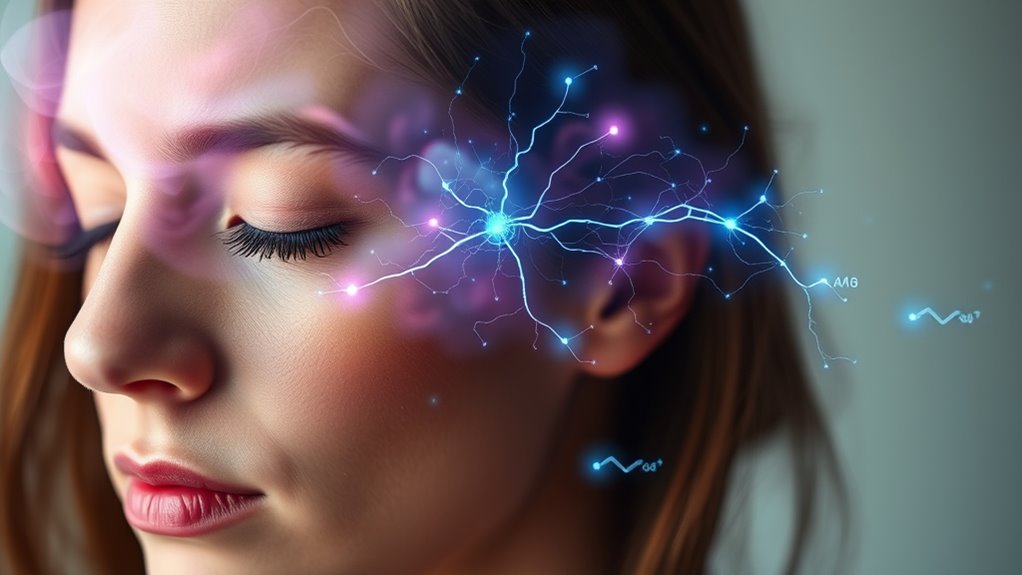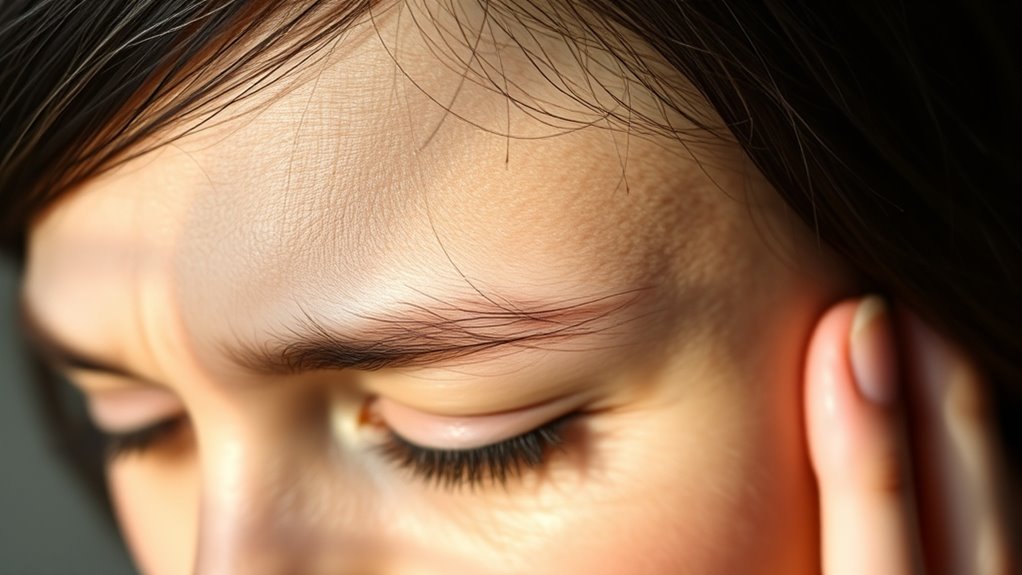Hormonal fluctuations, especially drops in estrogen just before your period, can trigger menstrual migraines by affecting your brain chemistry, blood vessels, and inflammation. When estrogen levels fall, they disrupt neurotransmitters like serotonin, making your brain more sensitive to pain. These hormonal changes influence how your blood vessels behave and activate inflammatory responses, worsening headaches. To learn how these mechanisms connect and ways to manage migraine triggers, keep exploring this important topic.
Key Takeaways
- Fluctuations in estrogen levels before menstruation decrease serotonin production, increasing pain sensitivity and triggering migraines.
- The sharp decline in estrogen during the menstrual cycle destabilizes brain chemistry, activating pain pathways.
- Hormonal changes influence blood vessel behavior, causing vasodilation or vasoconstriction linked to migraine onset.
- Fluctuating hormones trigger inflammatory responses that sensitize nerve endings, contributing to headache development.
- Individual hormonal responses and timing of hormone drops determine the occurrence and severity of menstrual migraines.
The Role of Estrogen in Menstrual Cycles

Estrogen plays a crucial role in regulating the menstrual cycle by influencing various hormonal and physiological processes. As estrogen levels rise during the first half of your cycle, they stimulate the growth of the uterine lining and promote the release of luteinizing hormone (LH). This hormone surge triggers ovulation, releasing an egg from your ovary. After ovulation, estrogen levels decrease slightly, but they remain relatively high to support the thickening of the uterine lining. If pregnancy doesn’t occur, estrogen levels drop sharply, signaling your body to start menstruation. These fluctuations aren’t just about fertility—they also impact other systems, including your brain. Understanding estrogen’s role helps explain why hormonal shifts can trigger migraines, especially around your period. Additionally, ongoing research into AI safety measures highlights the importance of monitoring such complex biological systems to prevent adverse effects.
How Hormonal Fluctuations Affect Brain Chemistry

Hormonal fluctuations, especially in estrogen and progesterone, directly influence your brain chemistry. These changes affect neurotransmitter levels, which can trigger migraines or worsen existing ones. Understanding this connection helps you grasp how your hormones impact your migraine experiences.
Estrogen’s Impact on Neurotransmitters
As estrogen levels fluctuate throughout your menstrual cycle, they directly influence the balance of key neurotransmitters in your brain. When estrogen drops, it can decrease serotonin production, which plays a vital role in mood regulation and pain perception. Lower estrogen levels also impact dopamine, affecting motivation and alertness, and can alter levels of norepinephrine, influencing alertness and stress responses. These changes can make you more sensitive to pain and increase the likelihood of migraines. Estrogen helps regulate neurotransmitter receptors and promotes their proper functioning. When estrogen dips, this balance shifts, leading to neurochemical instability that can trigger headaches. Understanding this connection highlights why hormonal fluctuations can profoundly influence brain chemistry and migraine susceptibility during your menstrual cycle.
Progesterone and Brain Balance
Fluctuations in progesterone levels during your menstrual cycle also have a significant impact on brain chemistry, influencing mood and pain sensitivity. When progesterone drops, it can decrease the production of calming neurotransmitters like GABA, making you more prone to irritability and headaches. Elevated progesterone levels, on the other hand, promote relaxation and stabilize mood. This hormonal shift affects how your brain processes pain signals, potentially intensifying migraine symptoms around your period. Progesterone also interacts with neurotransmitters like serotonin, which regulate mood and pain perception. Maintaining balanced progesterone levels helps support brain chemistry stability, reducing headache severity. Understanding this connection allows you to better manage hormonal fluctuations and their impact on your menstrual migraines. Regular hormonal fluctuations can also influence neurotransmitter production, further affecting your migraine experience.
The Timing of Migraines in Relation to Menstrual Phases

Migraine episodes often follow a predictable pattern related to the menstrual cycle, with many women experiencing attacks at specific times. Typically, migraines occur just before your period starts, during your period, or shortly after it ends. This timing aligns with hormonal fluctuations, especially the rapid drop in estrogen levels. Some women notice migraines around ovulation, due to the surge in hormones during that phase. The timing varies from person to person, but understanding your cycle can help you anticipate when migraines might strike. Recognizing these patterns allows you to prepare and seek treatment proactively. By tracking your symptoms and menstrual phases, you can identify your most vulnerable times and work with your healthcare provider to develop effective strategies. Additionally, individual hormonal responses and reproductive health factors can influence migraine timing and severity.
Biological Mechanisms Behind Hormone-Related Headaches

Hormone changes during the menstrual cycle trigger a series of biological responses that can lead to headaches. Fluctuations in estrogen and progesterone influence the brain’s pain pathways by altering neurotransmitter levels, such as serotonin and prostaglandins. Reduced estrogen levels during menstruation can decrease serotonin production, making you more vulnerable to pain signals. Additionally, hormonal shifts affect blood vessel behavior, causing vasodilation or vasoconstriction, which can stretch or constrict blood vessels and trigger pain. These changes also activate inflammatory processes, releasing chemicals that sensitize nerve endings. Together, these mechanisms heighten your brain’s sensitivity to pain, making hormonal fluctuations a direct catalyst for migraines. Understanding these biological responses helps explain why hormone fluctuations are so closely linked to menstrual migraines. High refresh rates enhance the overall responsiveness of certain projectors, illustrating how smooth, quick changes in visual data can improve user experience.
Common Symptoms and Warning Signs of Menstrual Migraines

Menstrual migraines often come with a distinct set of symptoms that can signal an upcoming attack. You might notice throbbing or pulsing pain on one side of your head, often centered around your temples or behind your eyes. Sensitivity to light, sound, or strong smells is common, making you seek a quiet, dark space. Nausea or even vomiting can accompany the headache, leaving you exhausted. You might also experience visual disturbances such as flashing lights, zigzag lines, or blind spots before the pain starts. Some women feel a sense of fatigue or irritability as warning signs. Recognizing these symptoms early can help you prepare or take medication to minimize the impact of the migraine. Being aware of these signs empowers you to manage your symptoms proactively. Additionally, understanding the hormonal fluctuations that trigger these migraines can aid in developing effective prevention strategies.
Factors That Increase Susceptibility to Hormonal Migraines

Certain factors can make you more prone to hormonal migraines, especially those related to fluctuations in your body’s natural hormone levels. Understanding these can help you identify your risk. For instance, engaging in outdoor activities like hiking or camping can influence your overall stress levels and sleep patterns, potentially affecting migraine susceptibility. 1. stress: Imagine a tight rope pulling at your nerves, increasing your sensitivity to hormonal shifts. 2. Irregular sleep patterns: Picture your sleep schedule as a roller coaster, disrupting your hormonal balance. 3. Dietary triggers: Visualize sudden sugar crashes or caffeine spikes that heighten your headache susceptibility. 4. High physical or emotional stress: Think of your body’s stress response as a storm, amplifying hormonal fluctuations. Recognizing these factors allows you to take proactive steps to minimize your risk and better manage potential migraines.
Treatment Options and Management Strategies

You can manage menstrual migraines effectively by exploring hormonal therapies that balance your cycle. Incorporating lifestyle changes and preventive measures also plays a vital role in reducing frequency and severity. Together, these strategies offer a thorough approach to controlling your migraines. Additionally, understanding the role of forsale 100 in supporting access to necessary treatments can be beneficial.
Hormonal Therapies Effectiveness
How effective are hormonal therapies in managing menstrual migraines? They can be quite helpful, especially when timed correctly. You might experience fewer migraines or less intense pain. Hormonal therapies work by stabilizing estrogen levels, preventing the sharp drops that trigger headaches. Here are some ways they achieve this:
- Birth control pills: Regulate hormones, reducing migraine frequency.
- Estradiol patches: Provide steady hormone levels, avoiding dips.
- Gonadotropin-releasing hormone (GnRH) agonists: Suppress ovulation, preventing hormonal fluctuations.
- Supplements like progesterone: Balance hormones during critical times.
– Regular maintenance and monitoring, similar to maintaining air purifiers, ensure consistent treatment efficacy, helping to prevent breakthrough migraines.
While effective for many, these treatments aren’t universal. Consulting your healthcare provider helps tailor the right approach for your needs.
Lifestyle and Preventive Measures
Implementing lifestyle changes and preventive strategies can considerably reduce the frequency and severity of menstrual migraines. You should aim for a consistent sleep schedule, as irregular sleep can trigger headaches. Managing stress through relaxation techniques like meditation or deep breathing helps prevent attacks. Regular exercise boosts overall well-being and may decrease migraine frequency, but avoid intense workouts close to your period. Maintaining a balanced diet and staying hydrated are essential, as blood sugar dips and dehydration worsen migraines. Tracking your symptoms and menstrual cycle can identify patterns and triggers. Consider preventive medications if migraines are frequent, and consult your healthcare provider about over-the-counter options like NSAIDs. By adopting these strategies, you empower yourself to manage symptoms effectively and improve your quality of life.
Lifestyle Changes to Reduce the Frequency of Attacks

Making specific lifestyle changes can particularly reduce the frequency of menstrual migraine attacks. Start by establishing regular sleep patterns—go to bed and wake up at the same time each day. Prioritize balanced meals rich in fruits, vegetables, and lean proteins to stabilize blood sugar levels. Stay well-hydrated by drinking plenty of water throughout the day, avoiding dehydration triggers. Incorporate regular exercise, like brisk walking or yoga, to reduce stress and improve overall well-being. Additionally, understanding the role of hormonal fluctuations can help you better manage and anticipate migraine patterns.
The Impact of Hormonal Contraceptives on Migraines

Hormonal contraceptives can influence your migraine patterns, but their effects vary depending on the type you use. Changes in hormone levels may trigger or lessen migraines, making it important to understand your specific response. Managing triggers and choosing the right contraceptive can help you better control your migraines. Incorporating emotional intelligence into your healthcare decisions can also support better communication with your provider about your symptoms.
Contraceptive Types and Risks
Hormonal contraceptives can substantially influence the frequency and severity of menstrual migraines. Different types carry varying risks, so it’s crucial to understand how they might affect you.
- Combined oral pills: These contain estrogen and progesterone, which can sometimes trigger migraines or make them worse, especially in women prone to hormonal swings.
- Progestin-only methods: Usually better tolerated, but some women still experience migraines due to hormonal fluctuations.
- Hormonal IUDs: They deliver localized hormones, often reducing migraines, but individual responses vary.
- Contraceptive patches and rings: These deliver steady hormone levels but can cause migraines in some women due to hormonal stability or fluctuations.
Always discuss your migraine history with your healthcare provider before choosing a contraceptive method.
Hormone Fluctuations Effect
Hormone fluctuations caused by contraceptives can considerably impact migraine patterns. When you use hormonal contraceptives, your hormone levels may become more stable or fluctuate unpredictably, affecting your migraine frequency and severity. Some women experience relief, while others notice worsening symptoms. The type of contraceptive influences these effects; combined pills, for example, can suppress natural hormone cycles, leading to fewer migraines for some. However, sudden drops in estrogen, common during placebo weeks, may trigger headaches. Understanding these patterns helps you determine if your migraines are linked to hormonal changes. Here’s a quick overview:
| Contraceptive Type | Effect on Migraines | Hormone Level Changes |
|---|---|---|
| Combined Pill | Variable | Suppresses fluctuations |
| Progestin-only | Sometimes reduces | Maintains stable levels |
| Intrauterine Device | Often minimal | Local hormone release |
| Patch | Similar to pills | Steady hormone delivery |
| Injectable | Long-lasting effect | Fluctuations depending on dose |
Managing Migraine Triggers
Managing migraine triggers involves understanding how various factors, including contraceptive use, can influence your migraine patterns. Hormonal contraceptives can either alleviate or worsen your headaches depending on their composition and your body’s response. To manage these triggers, consider the following:
- Track your migraines to identify patterns related to contraceptive changes.
- Consult your healthcare provider before starting or stopping any birth control method.
- Choose contraceptives with stable hormone levels, like certain IUDs or patches, to reduce fluctuations.
- Be aware of side effects such as increased headache frequency or intensity, and adjust your plan accordingly.
Future Directions in Research and Personalized Care

As research advances, personalized approaches to menstrual migraine management are becoming increasingly feasible, promising more targeted and effective treatments. You may soon benefit from genetic testing that identifies your specific migraine triggers and hormone sensitivities. Researchers are exploring biomarkers to predict migraine attacks, allowing you to take preventive measures before symptoms start. New therapies tailored to your hormonal profile, such as customized hormone modulation or novel medications, are on the horizon. Digital health tools, like apps and wearables, will help monitor your patterns and provide real-time insights. These innovations aim to move beyond one-size-fits-all solutions, empowering you with personalized strategies that improve quality of life and reduce migraine frequency and severity. The future holds promise for more precise, individualized care.
Frequently Asked Questions
Can Menstrual Migraines Occur Outside the Typical Menstrual Cycle?
You might wonder if menstrual migraines can happen outside your regular cycle. While they’re most common around your period, hormonal fluctuations can still trigger migraines at other times. Factors like stress, sleep changes, or hormonal medications may cause these headaches. So, yes, even outside your typical cycle, hormonal shifts can lead to migraines, highlighting the importance of monitoring your symptoms and discussing them with your doctor for proper management.
Are There Genetic Factors Influencing Hormonal Migraine Susceptibility?
You might wonder if genetics play a role in hormonal migraine susceptibility. Research indicates that genetics can influence how your body responds to hormonal changes, potentially making you more prone to migraines. If a family member has migraines, your risk increases. Genetic factors may affect hormone receptors or neurotransmitter pathways, heightening your chances of experiencing migraines during hormonal fluctuations. Understanding your family history can help you manage and anticipate these migraines better.
How Do Age and Menopause Affect Menstrual Migraine Patterns?
As you age and approach menopause, your menstrual migraine patterns often change. You might notice migraines become less frequent or severe due to fluctuating hormone levels. Menopause causes estrogen levels to drop and stabilize, which can reduce hormone-related headaches. However, some women still experience migraines during this time. Tracking your symptoms helps you understand your patterns, and discussing options with your doctor can improve your quality of life.
What Role Does Progesterone Play in Menstrual Migraines?
Think of progesterone as a balancing act in your body’s hormonal orchestra. When levels drop before your period, it’s like the conductor stepping back, causing chaos. This hormonal shift can trigger migraines because it influences serotonin and blood vessels in your brain. You might notice headaches worsening during this time, as progesterone’s decline disrupts your usual harmony, making you more sensitive to pain and headaches.
Are Hormonal Fluctuations Linked to Other Types of Headaches?
You might notice hormonal fluctuations are linked to other headaches beyond menstrual migraines. Changes in estrogen and progesterone levels can influence brain chemicals and blood flow, leading to tension headaches or cluster headaches. These hormonal shifts affect your body’s response to stress and pain, making headaches more likely during certain times like pregnancy, menopause, or hormonal therapy. Recognizing these patterns can help you manage or prevent these headaches more effectively.
Conclusion
Understanding how hormones influence migraines can help you manage them better. Did you know that women are three times more likely to experience menstrual migraines than men? By recognizing your triggers and exploring treatment options, you can reduce the frequency and intensity of your headaches. Staying informed and working with your healthcare provider empowers you to take control of your health and find relief tailored to your unique hormonal cycle.









